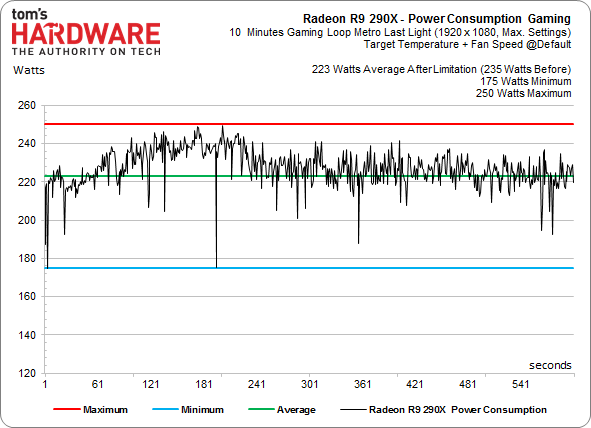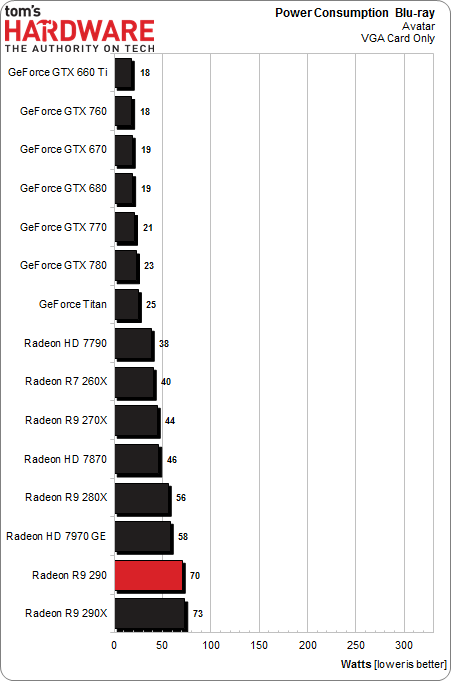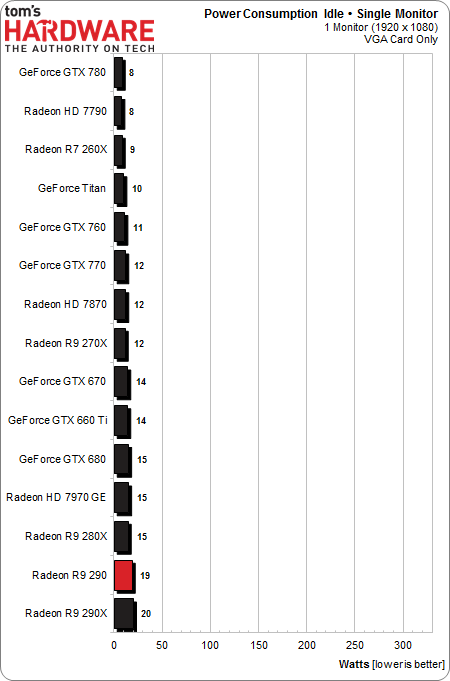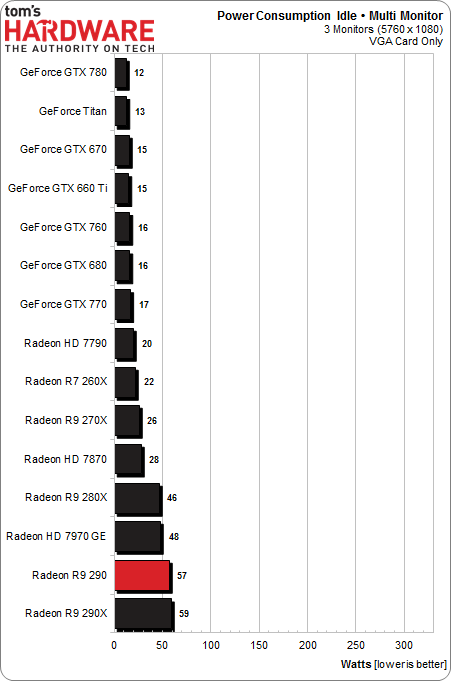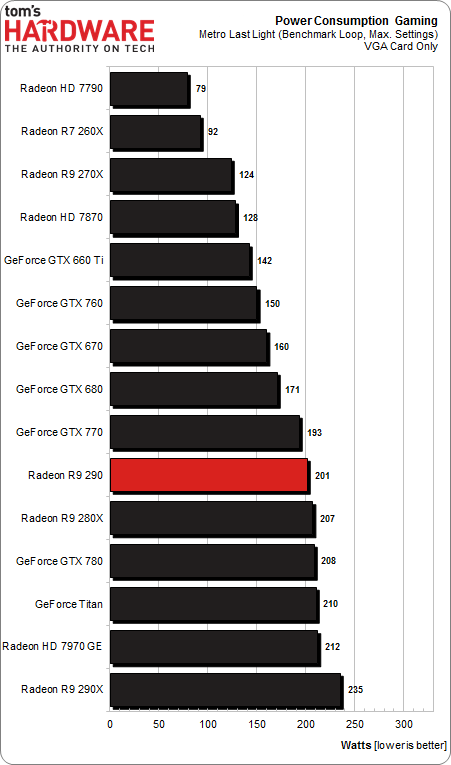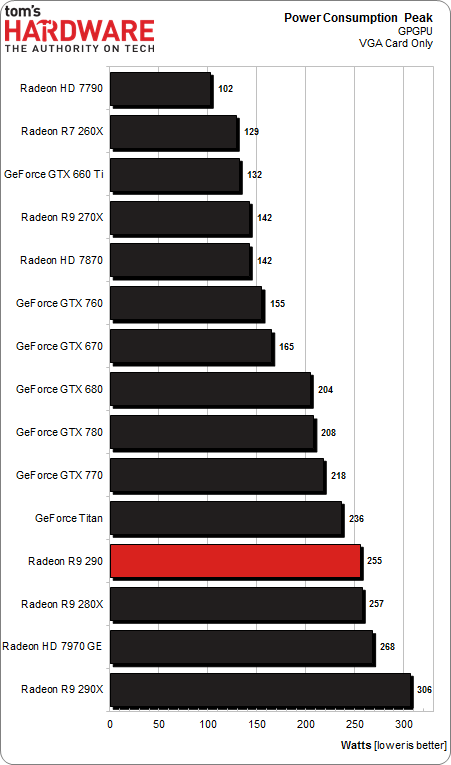AMD Radeon R9 290 Review: Fast And $400, But Is It Consistent?
We have all the makings of a dramatic launch: new high-end hardware, a last-minute delay for more performance, a crazy twist based on retail hardware, and our own home-baked solution to AMD's noise problem. Does Radeon R9 290 impress us or fall short?
Power Consumption Overview
AMD Radeon R9 290X Correction
Ultimately, any piece of equipment can fail, and this is what happened to our current clamp while we were benchmarking the Radeon R9 290X. That means some of the power consumption results in our launch article weren't quite right. Power was one of the last things we measured, and not only are the Radeon R9 290X’s numbers for the gaming loop too low, but the error got worse with time, increasingly throwing off the curve. Thus, we're repeating our readings on the 290X and presenting the corrected curve below. Also, we've taken steps so this doesn't happen again, using additional equipment and comparing the results through different methods.
On the bright side, the Radeon R9 290X we're using for our new power consumption benchmark isn’t a press sample sent to us by AMD, but an off-the-shelf retail card.
Power Consumption Overview for All Graphics Cards
Here are the power consumption numbers for all of the benchmarked graphics cards, including the corrected Radeon R9 290X results.
Bottom Line
Once again, the Radeon R9 290X’s power consumption at idle is very high, and it gets a lot worse when a second or third monitor is connected. The Blu-ray playback results are also far from satisfactory. Things get a lot better when it comes to gaming loops, where the Radeon R9 290X is much improved over AMD’s Tahiti. This lets it gain a lot of ground on the more efficient Nvidia graphics cards. Seeing that the gap is really not that large any more, what remains might eventually even be eliminated completely with performance increases due to driver optimizations.
Get Tom's Hardware's best news and in-depth reviews, straight to your inbox.
Current page: Power Consumption Overview
Prev Page Detailed Gaming Efficiency Results Next Page Noise And Video Comparison-
slomo4sho This is a win at $400! Good job AMD!Reply
http://techreport.com/review/25602/amd-radeon-r9-290-graphics-card-reviewed/9
11865199 said:However, the two retail Radeon R9 290X boards in our lab are both slower than the 290 tested today. They average lower clock rates over time, pushing frame rates down. Clearly there’s something wrong when the derivative card straight from AMD ends up on top of the just-purchased flagships. So who’s to say that retail 290s won’t follow suit, and when we start buying those cards, they prove to underperform GeForce GTX 780? We can only speculate at this point, though anecdotal evidence gleaned from our experience with R9 290X is suggestive.
Chris, these results differ drastically from real world results from 290X owners at OCN... I understand that your observations are anecdotal and based on a very small sample size but do you mind looking into this matter further because putting such a statement in bold in the conclusion even though it contradicts real world experiences of owners just provides a false assumption to the uninformed reader...
The above claim has already escalated further than it should... A Swiss site actually has already rebutted by testing their own press sample with a retail model and concluded the following:
With the results in hand, the picture is clear. The performance is basically identical between the press copy and graphics card from the shelf, at least in Uber mode. Any single frame per second is different, which is what may be considered normal as bonds or uncertainty in the measurements.
In the quiet mode, where the dynamic frequencies to work overtime, the situation becomes slightly turbid. A minor performance difference can be seen in some titles, and even if it is not about considerable variations, the trend is clear. In the end, it does an average variance tion of only a few percent, ie no extreme levels. The reason may include slightly less contact with the cooler, or simply easy changing ambient temperature. -
Heironious This is weird, something must be wrong with your system. I have an i5-2500, GTX 780, 16 GB G Skill 1333, 500 GB samsung SSD, Windows 8.1 64 bit, and on Ultra with 4x MSAA I get 80 - 100 FPS....Reply -
Heironious Multiplayer would add more stress to the CPUs / GPU's. Like I said, something is wrong with their machine. I would prob get higher on single player. Im going to check and find out.Reply -
slomo4sho Reply11865222 said:According to Tom's Benchmarks Nvidia's price drop just became meaningless
Now to wait for the non-reference cards at the end of the month! -
jimmysmitty I agree that the stock cooling is pretty bad but in honesty, no matter how nice they make it after market is always better. The Titan may not have had after market but if it did it would have cooled better.Reply
It looks like a good card for the price as it even keeps up with the $100 more GTX780. This is good as NVidia may drop prices even more which means we could also see a price drop on the 290X and I wouldn't mind a new 290X Toxic for sub $500. -
guvnaguy In terms of potential performance it seems like a great card, but you get what you pay for with regards to chip quality and cooling.Reply
Best to wait a month or two before buying to see how this all goes down
